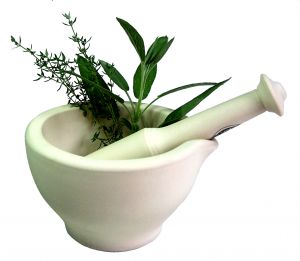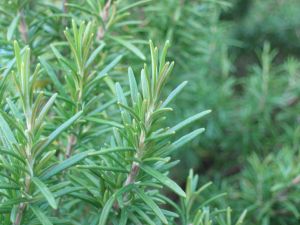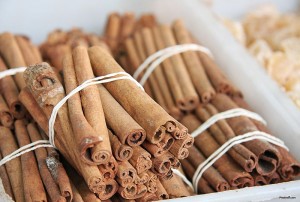

A Mortar and Pestle for Preparing Herbal Remedies Herbal RemediesFor centuries before there were pharmaceutical companies or even doctors, people relied on nature's bounty to cure diseases. Through trial and error they discovered the amazing curing powers of plants and herbs. Without any laboratories or double blind studies, folklore correctly identified that certain herbs had the ability to heal. This site is an online encyclopedia of the traditional uses of common everyday herbs that you can find in your own garden, as well as some lesser known but nevertheless worthy plants. It is based largely on the work of the great herbalists of the 18th century, and as such represents the traditional knowledge of untrained country "doctors" and herbalists. It is of course not meant as medical advice or a substitute for competent medical treatment. Always consult a physician with respect to any health condition and before taking any herbal remedies. 
Rosemary Rosemary - It's Not Just for CookingRosemary, Rosmarinus officinalis, is a shrub of the Lamiaceae (or Labiatae) family of plants growing in the wild around the Mediterranean, especially in arid scrubland and on rocky ground, such as limestone. It is grown in gardens. Rosemary has many medicinal qualities, but it is also an herbal condiment, a honey plant (honey made from rosemary flowers is highly prized), and an ingredient commonly used in perfumery. Rosemary can grow up to 1,50 m in height. It is easily recognizable in any season by its distinctive leaves which are without persistent petioles, coriaceous, much longer than wide, with slightly rolled edges, and dark shiny green on top, whitish below. Rosemary smells somewhat like camphor and is reminiscent of incense. 
Cinnamon The Health Benefits of CinnamonCinnamon is a spice which is relatively common in both the West and in the East. The name cinnamon is used to refer to different plants. The two most commonly used as spices are the Cinnamomum zeylanicum, and Cinnamomum aromaticum (Nees). Cinnamon Cinnamomum zeylanicum, also known as Cinnamomum verum is a small evergreen tree about 10-15 m high, of the family Lauraceae. The plant is native of Sri Lanka and the spice that it yields is the finest and most expensive. Cinnamon Cinnamomum cassia Nees, also of the family Lauraceae, is also known as cassia, and has a harsher flavor, and is less expensive. As a result, the Cinnamon Cinnamomum zeylanicum is harder to find, or it may be mixed with the lower priced Cinnamon Cinnamomum cassia Nees. It is produced in Vietnam, Sumatra and Indonesia. Browse Herbs Alphabetically: A | B | C | D | E | F | G | H | I | J | K | L | M | N | O | P | Q | R | S | T | U | V | W | X | Y | Z |
Advertisement
|
||
|
|||